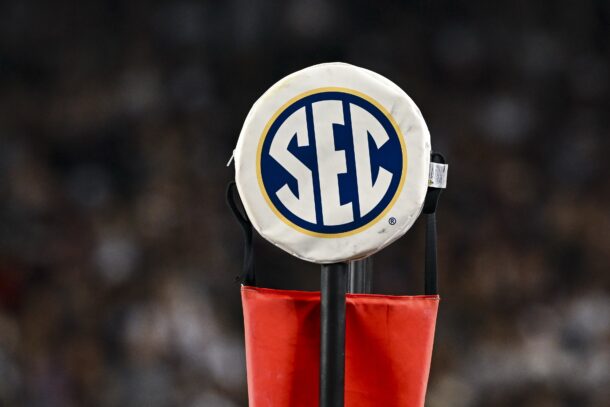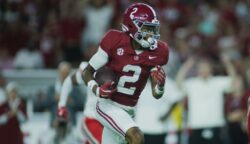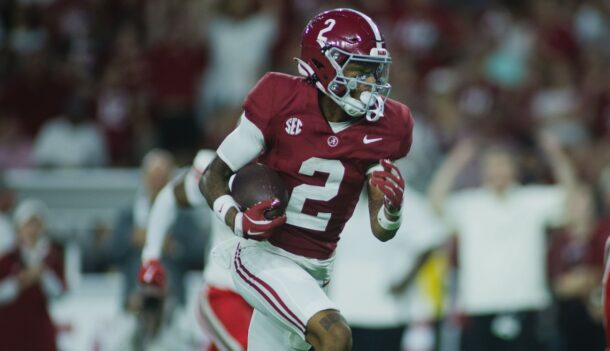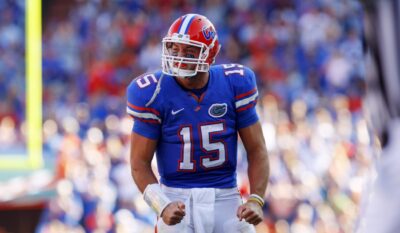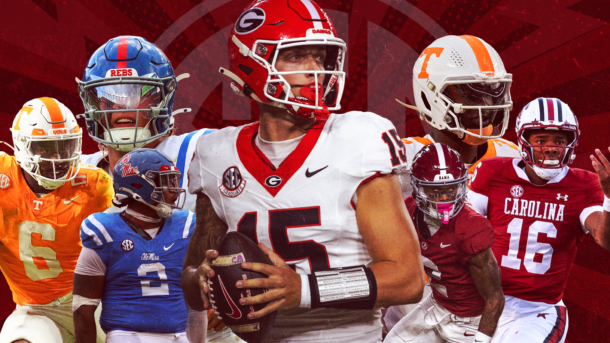
Monday Down South: Bama has no one to blame for its Playoff snub but Bama, plus MDS’ 2024 Awards Show
By Matt Hinton
Published:
Takeaways, trends and technicalities from Championship Weekend in the SEC.
In keeping with tradition, the final regular-season edition of Monday Down South will honor the best of the season with its annual individual awards and All-SEC team. But first!
The committee’s job was easy
Both ESPN and the CFP committee are constantly accused of being in the tank for the SEC, in general, and for Alabama, specifically, which historically has been hard to refute. Alabama has tended to guarantee that it will be hard to refute, by being so damn good all the time.
Opportunities to snub the Tide have not have exactly abounded. In the first decade of the Playoff’s existence, they sailed into the final four 8 times in 10 years, rarely with a whiff of doubt. Only 1 of those teams (in 2017) made the cut as an at-large, and all but 2 earned a No. 1 or No. 2 seed. Even last year, when the committee resolved the first genuine controversy in its history in Bama’s favor, it was only because Bama forced the issue, capping an 11-game winning streak with a season-defining upset over wire-to-wire No. 1 Georgia in the SEC title game. You could argue (and I still would) that the 2023 Crimson Tide didn’t deserve the final ticket over undefeated Florida State; you could not argue that they weren’t “a Playoff team,” by any prevailing standard of what a Playoff team looks like.
This year? In the end, after weeks of speculation and chaos, there was hardly any point in arguing at all. As soon as the game-winning field goal tumbled over the crossbar to clinch Clemson’s 34-31 win over SMU on Saturday night, it was all over but the shouting. Suddenly it was like the answer to the final exam fell harmlessly into the committee’s lap. Tasked with setting a precedent for what an at-large team in the expanded 12-team format looks like, they were left with the only result that would have allowed them to salvage some dignity: Not Alabama. Not this time. Thank God.
Not there wasn’t going to be some shouting. ESPN, less committed to advancing the Tide’s case in particular than to generating an aura of intrigue leading up to the live Sunday-morning CFP selection show, spent the weekend laying the groundwork for exactly the scenario that unfolded. The network stoked the Bama vs. SMU “debate” at every opportunity over the previous 24 hours, with every person who appeared on camera during an ESPN or ABC broadcast addressing the merits over a graphic comparing sad thumbnail versions of their respective résumés. (The graphic, emphasizing “record vs. Top 25” and strength of schedule, conspicuously omitted the Crimson Tide’s losses to 2 of the weakest teams on its schedule, Vanderbilt and Oklahoma — surely a mere routine oversight.)
By the 4th quarter of the ACC Championship Game, which opened with the Mustangs trailing Clemson 31-14 and their shot at the ACC’s automatic bid hanging by a thread, the tenor on the broadcast and on social media was was inflamed. Did they just blow it? Did the margin doom SMU to drop? Did the door just swing open for the most erratic, uninspiring Bama team since the introduction of the iPhone to back its way into the field?
The Mustangs’ 4th-quarter rally to tie the game before ultimately falling on a 56-yard, walk-off bomb made them easier to defend, although it didn’t seem to do much for their defenders’ confidence. The broadcast team calling the game, Sean McDonough and Greg McElroy, felt compelled to stump for SMU as they signed off for the night, but instead of simply saying something like “safe to say SMU will be in,” they sounded like they were pleading on behalf of a doomed client in front of a judge whose mind was already made up. The specter of Bama loomed and memories of last year’s surge in the final rankings were fresh.
It went on like that, angst building overnight right up until the deliberately drawn-out bracket reveal on Sunday, which wrung every last ounce of suspense out of the proceedings before announcing … it’s SMU, of course, off to a first-round date at Penn State in a matchup 4 decades in the making. At which point the “controversy” immediately had all the makings of MacGuffin. One minute, Alabama was too big to snub; the next, it was bound for the ReliaQuest Bowl. The line spoiled faster than a ripe avocado in the sun.
What is it ever real? For what it’s worth, if SMU had beaten Clemson (thereby claiming the ACC’s auto bid and eliminating the Tigers), all signs are that Alabama would have been the next team up in the at-large pool. In case of a Clemson win, though, the prospect of Bama jumping SMU was a harder sell. It took most of last week to pick up steam. On Friday, coach Rhett Lashlee attempted to get out ahead of the emerging narrative by declaring “the case is closed” on whether his team had already sewn up a spot. After all, the Mustangs entered the game ranked No. 8 in the committee’s weekly rankings, 3 spots ahead of Alabama. Lashlee argued, persuasively, that to demote a team that was clearly above the line one week for the sin of losing its conference championship game the next, to the benefit of a team that didn’t even qualify for its conference championship game, would be a blow to the integrity of the process.
“We did the right thing. We showed up. We value the opportunity to play in a conference championship game,” he said. “We’re going to show up and do the right thing and not find a way to bounce out because we were told on Tuesday night (in the weekly CFP rankings show) that if you don’t play, you’re in at 8.” The obvious implication being that, if the committee set a precedent that a team that loses its 13th game is at risk of being replaced by a team whose season ended at 12, maybe the next team that finds itself in SMU’s position decides that showing up isn’t worth it.
Lashlee was right, and the committee did right by his team following its down-to-the-wire defeat, dropping the Mustangs 2 spots (behind fellow Playoff teams Indiana and Boise State, one of the weekend’s big winners) but still a spot ahead of Alabama for the last at-large ticket.
In fact, the final rankings set a firm precedent across the board that losing a conference championship game is a minor citation at worst, especially if it’s competitive. Penn State and Texas dropped just 1 spot apiece in the CFP rankings following their narrow losses to the top 2 seeds, Oregon and Georgia, and even Iowa State fell just 2 spots despite its wipeout loss to Arizona State for the Big 12 crown. UNLV fell but remained in the Top 25 despite its decisive loss at Boise on Friday night. The committee got the message.
Just as important, though, was the message it sent about where its priorities lie on the bubble. Alabama hoped its big-ticket wins over Georgia, South Carolina and LSU, appeals to its overall strength of schedule, and, yes, residual respect for its brand would carry more weight than its historic flops against Vanderbilt and Oklahoma, 2 of Alabama’s worst losses since the turn of the century. If anything, though, the brand — defined for years by week-in, week-out, machine-like consistency against opponents lower on the food chain — worked against Bama for a change, by highlighting just how far removed the post-Saban Tide already are from the teams that made a point of never leaving their fate up for debate.
The ’23 edition, a basketcase in its own right early in the season, made the committee’s job hard by leveling up over the course of the year and actively playing its way into Playoff viability. The ’24 edition, blessed with a much wider margin for error, made the committee’s job easy by repeatedly making the case against itself.
A few good rules of thumb for aspiring Playoff teams in the future: Don’t stumble hung over into an ambush by a perennial league doormat on a 10-game conference losing streak. Don’t get blown out by the worst Oklahoma team a generation in the 11th game of the year. Don’t find yourself sitting at home on the last Saturday of the regular season, rooting for a team that earned the right to play in its championship game to get knocked off the ladder while you’re watching from the couch because you didn’t.
Appeals to conference chauvinism also backfired. Could SMU “survive” an SEC schedule? Maybe, maybe not. (Whose schedule do they get? I’ll just point out here that Tennessee and Texas are both in the Playoff with 1 combined victory over a ranked opponent between them: The Vols’ win over Alabama.)
But SMU did survive the schedule it was actually presented, winning 9 straight vs. Power Conference opponents between its only 2 losses, both down-to-the-wire decisions decided on a pair of late field goals against opponents ranked 16th and 17th in the final CFP rankings. Meanwhile, among the teams that actually struggled to survive an SEC schedule was, of course, Alabama. The Tide finished 5-3, in a 6-way tie for 4th through 9th place while biting the dust against 2 of the league’s most mediocre, imminently beatable teams this season. (See also: Ole Miss. You cannot come crying about strength of schedule after you lose your conference opener to a team that subsequently fails to win another conference game, or about “the grind” after you lose coming off an open date to an unranked team starting a true freshman backup quarterback.) SMU had plenty of Vanderbilts and Oklahomas on its schedule — and Kentuckys and Floridas — and took care of its business.
There was something a little bit sad about Alabama athletic director Greg Byrne responding to the snub with a vague statement about reassessing the Tide’s nonconference scheduling in the future in light of the committee’s lack of respect for strength of schedule, or something. Sad partly because it made no sense (Bama’s middling nonconference slate was not a point in its favor this year and had nothing to do with it getting left out), but mostly because he felt the need to respond at all. For years, Alabama was about “the standard” — setting it and playing up to it, regardless of the opponent. Now, less than 1 full season into the Kalen DeBoer era, his boss was groping for ways to perform outrage and deflect from the obvious: The season wasn’t up to the standard, or anywhere near it.
I suppose we’re in an era in this sport when no one is in the mood to hear someone in Byrne’s position concede “it just wasn’t our year” without signaling his willingness to go to the mat. There’s too much at stake. In Alabama’s case, especially, where the Tide still boast the nation’s most talented roster and still expect that every year is their year, the long-term implications of the regression in DeBoer’s first season are urgent enough without having to come to grips with the fact that the crimson A is no longer worth the benefit of the doubt. But if Byrne is just doing his job, so is the committee. And there’s nowhere else for Bama to look for landing on the wrong side of the line than in the mirror.
Monday Down South 2024 Awards Show
The best of the week year.
Most Valuable Player: Tennessee RB Dylan Sampson
Sampson has flown under the radar nationally, like pretty every running back in America not named Ashton Jeanty. But he’s been indispensable to Tennessee’s Playoff run, reaffirming his status as one of the most reliable and durable workhorses in the college game at (officially) just 5-11, 201 pounds. So far, Sampson has accounted for 100+ scrimmage yards in 11 of 12 games, setting single-season school records for total yards (1,626) and touchdowns (22) in the process. Against Power Conference opponents, specifically, that comes out to just shy of 35% of the Vols’ total output on more than 25 touches per game.
Offensive Player of the Year: Ole Miss QB Jaxson Dart
2024 was not a banner year for SEC quarterbacks as a group, snapping a streak of 6 Heisman finalists in as many years at the position dating to 2018. (Offensive production in general was significantly down across the conference.) But that certainly wasn’t for a lack of firepower from Dart, who finished atop the SEC and among the top 5 nationally in every category that matters — total offense, yards per attempt, overall passer rating, Total QBR, EPA, PFF grading, you name it.
He’ll leave Ole Miss as the Rebels’ career leader in total offense, passing yards (10,213) and pass efficiency, as well as with a school-record 27 wins as a starter. He’s 2nd in program history in TD passes (77), only 4 behind Eli Manning. The hunt for the elusive Playoff berth, however, falls to the next guy.
Defensive Player of the Year: Tennessee Edge James Pearce Jr.
In a crowded year for productive edge rushers*, Pearce’s raw stats don’t exactly leap off the page: Officially, he tied for 11th in the SEC in tackles for loss (11) and 8th in sacks, with 7.5. Both of those numbers are slightly down from last season. Look more closely, though — or simply turn on the film — and he was every bit as disruptive as his elite rep suggests.
Per PFF, he ranked among the Power 4 leaders in total QB pressures (52) and win percentage, beating opposing blockers on 23% of his pass-rushing snaps. Notably, he was at his best in the Vols’ season-defining, 24-17 win over Alabama in Week 8, generating a career-high 10 pressures and a pair of sacks in a money-making performance against the Tide.
If the Vols stand a chance of advancing out of the Ohio State/Oregon corridor of the bracket, they need their most NFL-ready prospect playing up to the distinction.
(*Before you scroll down to the all-conference team, I want to emphasize: It was an EXTREMELY crowded year for productive edge rushers in this conference.)
Fat Guy of the Year: Texas OT Kelvin Banks Jr.
Banks has been a “green light” guy from the moment he set foot on campus — blue-chip recruit, Day 1 starter as a true freshman, all-conference honors as a freshman and a sophomore (soon to be as a junior, too) — and he remains on the first-round track heading into what will almost certainly the final chapter of his college career in the Playoff. In his first season in the SEC, he was among PFF’s top-graded OL in the conference as both a run blocker and pass blocker, allowing a single sack while posting the 2nd-highest overall grade (85.7) of any full-time SEC lineman at any position. His status after sitting out Saturday’s overtime loss to Georgia due to an ankle injury is a significant variable in the Longhorns’ outlook against Clemson and beyond.
Most Exciting Player: Alabama WR Ryan Williams
Williams skipped his senior year of high school to enroll early in Tuscaloosa — he’s still only 17 years old, if you’re keeping track; his birthday is Feb. 9 — and in his case it was unquestionably the right decision. By the end of September, his reputation as an extraterrestrial talent was secure, cemented in an electric, 177-yard performance against Georgia that made him a household name across college football. (No small feat with an extremely generic name). I don’t have a separate entry for “Play of the Year,” because there are no other candidates aside from his ankle-breaking, 75-yard game-winner to beat the Dawgs.
Williams’ production cooled considerably over the second half of the year, yielding just 2 touchdowns over the last 7 games compared to 6 TDs in the first 5. (In keeping with the category, let’s go ahead and add the spectacular TD catch at Oklahoma that was wiped out by a phantom penalty while we’re at it.) But the possibility that you might see something you’ve never seen before every time he touches the ball is as palpable as ever.
Most Valuable Transfer: Ole Miss DL Walter Nolen
At Texas A&M, Nolen flashed glimpses of his blue-chip potential but never got all the way there under Jimbo Fisher. At Ole Miss, he arrived fully formed, exceeding the hype in his first (and likely only) season as a Rebel. For the season, Nolen led all interior d-linemen nationally with 14 tackles for loss, and posted the 2nd-best PFF grade against the run (91.9) behind only Michigan’s Mason Graham.
He collapsed pockets at a high rate for a tackle, generating 30 pressures with 6.5 sacks, and frequently looked unblockable when he wanted to be. Even assuming Nolen is NFL-bound after just 1 year in Oxford, the Rebels got their money’s worth.
Breakout Player of the Year: South Carolina QB LaNorris Sellers
Sellers’ upside was plain enough early in the season, even if his limitations were, too. But since an open date in Week 9, he’s emerged as a full-blown star over the course of a 6-game winning streak to close the regular season.
Don’t just go by the record: For the month of November, Sellers ranked No. 2 nationally in total offense and pass efficiency, and No. 1 in total touchdowns with 16 (12 passing, four rushing). In the same span, South Carolina averaged just shy of 500 yards per game, best in the SEC and 5th in the FBS, with Sellers accounting for just shy of 70% of that total.
And don’t just go by the stats, either: In the win over Clemson, he looked like the second coming of Cam Newton — a lofty comparison, but worth it — repeatedly turning shoulda-been sacks into big, loping gains in the open field on his way to 166 rushing yards. Per PFF, Sellers’ 18 missed tackles forced against the Tigers were the most in a single game this season by any FBS player not named Ashton Jeanty. With 164 passing yards, he also became the first FBS quarterback this season to rush and pass for 150+ yards in the same game, turning in a season high 92.5 Total QBR rating in the process.
Six games (1 vs. Wofford) is not exactly a foolproof sample size, but I’m gonna go ahead and say I don’t think this guy is turning back into a pumpkin anytime soon. Barring a meltdown in the Citrus Bowl, Sellers should be a tentative Heisman candidate heading into 2025; assuming his progress continues apace, he’ll be NFL-bound in ’26. Between its precocious quarterback, sophomore wideout Nyck Harbor, and freshman edge rusher Dylan Stewart, Carolina has the high-end talent to sustain the momentum of its November upswing over the offseason and open next season as a dark-horse Playoff contender, at worst.
Comeback Player of the Year: South Carolina RB Rocket Sanders
At Arkansas, Sanders achieved liftoff in 2022, accounting for an SEC-best 1,714 scrimmage yards and 12 touchdowns in one of the most productive seasons in Hogs history. In 2023, he never left the tarmac, grounded by foot and shoulder injuries that cost him half the season and visibly limited him for the other half. He portaled out last December, part of a mass exodus from Fayetteville, and landed in South Carolina with his future in flux.
He wasn’t quite back to looking like his old sophomore self in 2024, but he was close enough to reemerge as one of the league’s most productive backs, accounting for nearly 1,200 scrimmage yards and 13 touchdowns. That included a handful of monster games against LSU (154 yards, 2 TD), Texas A&M (236 yards, 2 TDs) and Vanderbilt (178 yards, 3 TDs), as well as a couple of 100-yard outings against Alabama and Clemson. Like Sellers, Sanders’ production spiked during Carolina’s November surge; unlike Sellers, he’s unlikely to be back to extend the momentum into next year.
Rookie(s) of the Year: Texas Edge Colin Simmons / South Carolina Edge Dylan Stewart
Stewart and Simmons were ranked No. 1 and No. 2 among incoming edge rushers in the 2024 recruiting class, and wasted no time justifying the billing as true freshmen. Stewart made a bigger splash right away, emerging as an instant pass-rushing star out of the gate; Simmons didn’t need much longer, quickly establishing himself as a mainstay on the SEC’s best statistical defense. Together, they combined for 78 QB pressures, 21.5 TFLs, 14.5 sacks and 6 forced fumbles. They’re poised to be twin terrors across the conference for the foreseeable future.
Overachiever of the Year: Texas DB Michael Taafe
A former walk-on surrounded by blue-chips in Texas’ secondary, Taafe played his way into a starting role in 2023 and broke out in ’24, finishing with top overall PFF grade (91.4) of any SEC defender. His unsung presence is a major reason the Longhorns rank No. 1 or 2 nationally in nearly every category related to pass defense, including yards per attempt, pass efficiency, interceptions and completions of 10+ yards allowed.
Best Player on a Bad Team: Auburn RB Jarquez Hunter
Pound for pound, touch for touch, Hunter was arguably the conference’s most productive back in 2024, churning out 1,201 yards on 6.4 per carry. It was Auburn fans’ burden to wonder why he wasn’t carrying it more. Hunter only logged 20 carries in SEC play twice, coinciding with the Tigers’ only 2 conference wins: A 24-10 decision at Kentucky, where he went off for a career-high 278 yards and 2 touchdowns on 23 carries; and a 43-41, quadruple-overtime thriller over Texas A&M, in which he ran 28 times for 130 yards and 3 touchdowns.
Correlation is not causation — often success on the ground is an effect of playing with a lead, not the cause — but given that all 9 of the Tigers’ games Power 4 opponents were competitive, 4-quarter games that didn’t demand that they abandon the run, Hunter’s frequent disappearances from the offense in favor of Payton Thorne putting it in the air were consistently maddening. Run the dang ball.
Best Unit: Ole Miss’ Defensive Line
Ole Miss invested heavily over the past 2 seasons in upgrading its defensive front via the portal and traditional recruiting, and it paid off this year in a deep, frequently dominant unit that was capable of taking over every game it played. The Rebels led the nation in sacks, tackles for loss and Havoc Rate, legitimately boasting a full-time, 6-man rotation that was the envy of the conference.
The line set the tone in their Week 11 upset over Georgia, shutting down the Dawgs’ ground game while relentlessly hounding Carson Beck into 5 sacks and 2 turnovers in one of the most satisfying triumphs in Ole Miss history. The failure to convert that win and this group’s general dominance into a Playoff bid is going to sting for a long time.
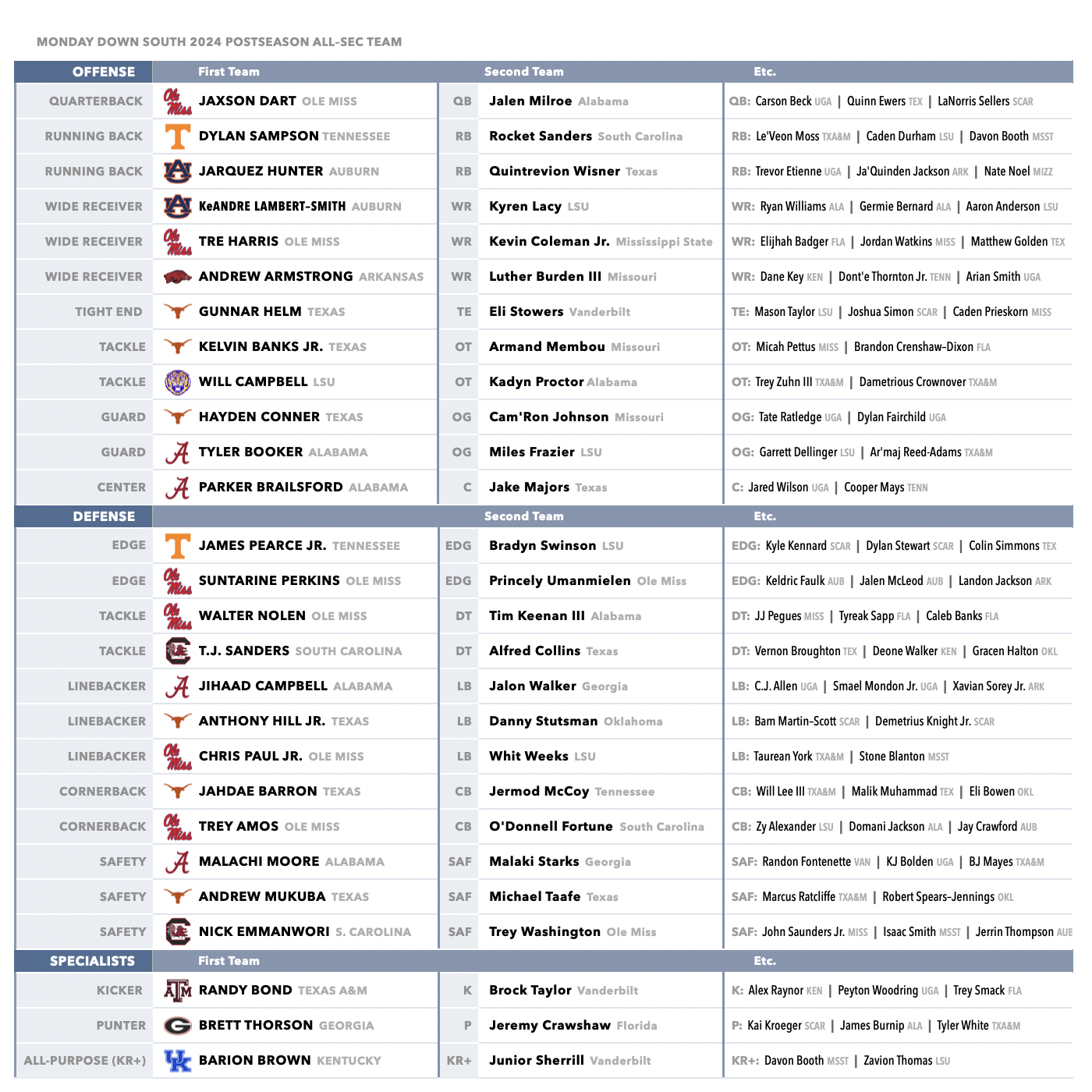
Matt Hinton, author of 'Monday Down South' and our resident QB guru, has previously written for Dr. Saturday, CBS and Grantland.
